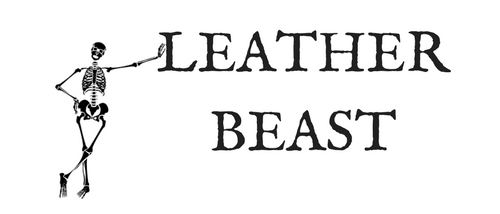4 Grades of Leather and What You Should Know About Them.
Full Grain Leather
Have you ever been shopping for leather and come across the myriad of terms used to describe the type of tannage, or leather grade, finish, etc that is involved in processing it? This was one of the most confusing things (and still can be confusing!) when I first started to work with leather.
It was especially confusing, since I was purchasing my leather mostly online and couldn’t even rely on my basic sense of touch to maybe piece together what some of these terms even mean.
Leather manufacture from it's earliest processes involving urine, feces and brains (still used today in smaller operations!) to the now majorly chemical and scientific processes is, well, complex.
Below i’ll describe the 4 different grades of leather and some of the main characteristics that I’ve come across and that helps me to keep things straight. This is in no way an exhaustive list of characteristics as the definitions can be loose and processes are always evolving but it is more meant to give you a basic understanding and introduction to the different grades.
1| Full Grain Leather
Lets start with the cream of the crop and work our way down. Full grain leather is regarded as your top-of-the-line leather.
This is the most expensive and sought after leather available mainly because it is fully intact except for the hair.
What do I mean by fully intact?
I mean that the leather surface has not been buffed, shaved down or corrected in anyway as opposed to some of the other grades.
You might be thinking, "isn't corrected a good thing?
We'll when the general consensus is that there's nothing wrong in the first place, then no it's not a good thing.
Obviously, there are other factors that come into play whenever you're choosing your leather for a specific project. But in mine and most other traditional leatherworker's opinions, the natural color and imperfections that they are "correcting" are actually good things and what gives a hide of leather it's unique charm and character.
Full grain leather is also the thickest leather due to lack of buffing of the surface and splitting. This means that full grain leather is the most durable and strongest leather.
Since there is no protective top coat on this leather, it allows it to develops a great patina as it ages, but this also means that it is also less resistant to stains since there is nothing protecting the leather straight out of the gate.
2| Top grain
Top grain leather is your 2nd best leather. This leather has been corrected at the surface. The top surface layer is buffed to remove imperfections like insect bites scars so it can have a more uniform appearance.
However this buffing can create a less natural looking leather to some.
This leather is also split in thickness leaving you with a thinner more manageable piece of leather to work with, but also a weaker leather. Still strong, but not a strong as the full grain.
Due to the protective coating that is applied to the surface, it does not stain. The coating protects it from any stains from spills and does not allow moisture to penetrate. However, it also does not breath as well or patina due to the protective coating.
3| Corrected Grain or split leather
Corrected grain or Split leather can also be referred to as genuine leather which you probably already know that genuine leather isn't saying much. To be honest this category has more than a handful of names that it goes by which can make it a confusing category, but the main points to know are as follows.
This leather is the bottom or fleshy part of the leather which is split from the top more strong layer. An artificial grain is embossed to the surface in an attempt to make it appear like a natural piece of leather.
Corrected grain leather is not nearly as strong or durable as the full or top grain leather and most experienced leatherworkers would not recommend using this type of leather at all.
4| Bonded leather
Bonded leather is a man-made material made by taking the scraps of leather and leftover leather fibers and bonding them together with various polymers and fillers to create something that appears like leather.
This is very low quality leather and not durable at all. It is mainly used in cheap furniture or accessories manufacturing.
This leather can also be called reconstituted or blended leather.
Of these 4 types of leather, the full and top grain are generally the only ones worth working with if the idea is to pull a lot of work into and have it last for a long time. It will be up to you to determine what type you decide to use in your next traditional leatherworking project.
What grade of leather do you use and why?



